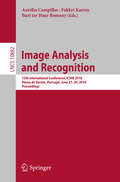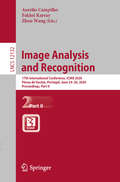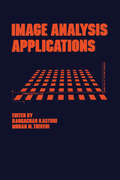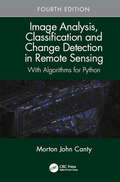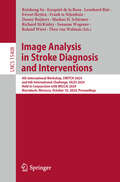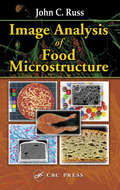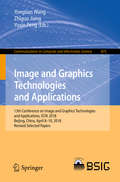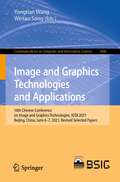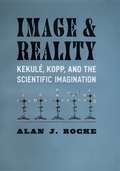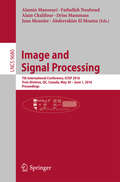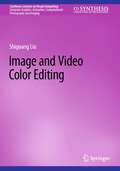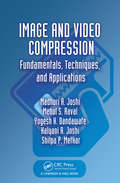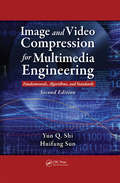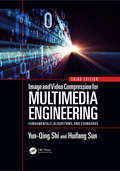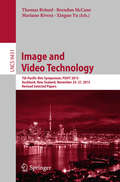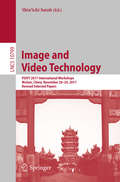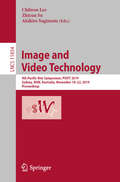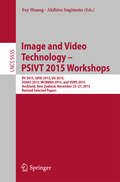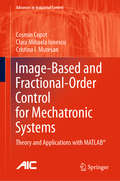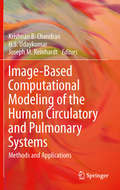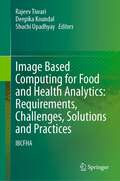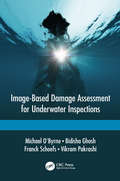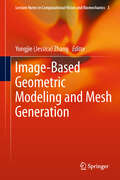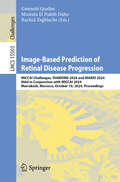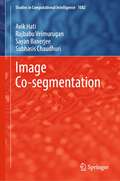- Table View
- List View
Image Analysis and Recognition: 15th International Conference, ICIAR 2018, Póvoa de Varzim, Portugal, June 27–29, 2018, Proceedings (Lecture Notes in Computer Science #10882)
by Aurélio Campilho Fakhri Karray Bart ter Haar RomenyThis book constitutes the thoroughly refereed proceedings of the 15th International Conference on Image Analysis and Recognition, ICIAR 2018, held in Póvoa de Varzim, Portugal, in June 2018.The 91 full papers presented together with 15 short papers were carefully reviewed and selected from 179 submissions. The papers are organized in the following topical sections: Enhancement, Restoration and Reconstruction, Image Segmentation, Detection, Classication and Recognition, Indexing and Retrieval, Computer Vision, Activity Recognition, Traffic and Surveillance, Applications, Biomedical Image Analysis, Diagnosis and Screening of Ophthalmic Diseases, and Challenge on Breast Cancer Histology Images.
Image Analysis and Recognition: 17th International Conference, ICIAR 2020, Póvoa de Varzim, Portugal, June 24–26, 2020, Proceedings, Part II (Lecture Notes in Computer Science #12132)
by Aurélio Campilho Fakhri Karray Zhou WangThis two-volume set LNCS 12131 and LNCS 12132 constitutes the refereed proceedings of the 17th International Conference on Image Analysis and Recognition, ICIAR 2020, held in Póvoa de Varzim, Portugal, in June 2020.The 54 full papers presented together with 15 short papers were carefully reviewed and selected from 123 submissions. The papers are organized in the following topical sections: image processing and analysis; video analysis; computer vision; 3D computer vision; machine learning; medical image and analysis; analysis of histopathology images; diagnosis and screening of ophthalmic diseases; and grand challenge on automatic lung cancer patient management.Due to the corona pandemic, ICIAR 2020 was held virtually only.
Image Analysis Applications
by Rangachar Kasturi, Mohan M. TrivediThis book presents a wide spectrum of applications where image analysis has been successfully employed, providing the reader with an insight into the merits or demerits of a particular technique. It deals with the domain of graphics recognition, document analysis, and map data interpretation.
Image Analysis, Classification and Change Detection in Remote Sensing: With Algorithms for Python, Fourth Edition
by Morton John CantyImage Analysis, Classification and Change Detection in Remote Sensing: With Algorithms for Python, Fourth Edition, is focused on the development and implementation of statistically motivated, data-driven techniques for digital image analysis of remotely sensed imagery and it features a tight interweaving of statistical and machine learning theory of algorithms with computer codes. It develops statistical methods for the analysis of optical/infrared and synthetic aperture radar (SAR) imagery, including wavelet transformations, kernel methods for nonlinear classification, as well as an introduction to deep learning in the context of feed forward neural networks. New in the Fourth Edition: An in-depth treatment of a recent sequential change detection algorithm for polarimetric SAR image time series. The accompanying software consists of Python (open source) versions of all of the main image analysis algorithms. Presents easy, platform-independent software installation methods (Docker containerization). Utilizes freely accessible imagery via the Google Earth Engine and provides many examples of cloud programming (Google Earth Engine API). Examines deep learning examples including TensorFlow and a sound introduction to neural networks, Based on the success and the reputation of the previous editions and compared to other textbooks in the market, Professor Canty’s fourth edition differs in the depth and sophistication of the material treated as well as in its consistent use of computer codes to illustrate the methods and algorithms discussed. It is self-contained and illustrated with many programming examples, all of which can be conveniently run in a web browser. Each chapter concludes with exercises complementing or extending the material in the text.
Image Analysis in Stroke Diagnosis and Interventions: 4th International Workshop, SWITCH 2024, and 6th International Challenge, ISLES 2024, Held in Conjunction with MICCAI 2024, Marrakesh, Morocco, October 10, 2024, Proceedings (Lecture Notes in Computer Science #15408)
by Ruisheng Su Ezequiel de la Rosa Leonhard Rist Ewout Heylen Frank Te Nijenhuis Danny Ruijters Markus D. Schirmer Richard McKinley Susanne Wegener Roland Wiest Theo van WalsumThis book constitutes the refereed proceedings of the 4th International MICCAI Stroke Workshop on Imaging and Treatment Challenges, SWITCH 2024, as well as the Ischemic Stroke Lesion Segmentation Challenge, ISLES 2024, held in conjunction with MICCAI 2024, in Marrakesh, Morocco, on October 10, 2024. The 12 revised full papers presented in this volume were selected form 16 submissions. The papers describe research advancements in image analysis for the diagnosis and intervention of ischemic and haemorrhagic stroke and present the latest developments in segmentation, disease prognosis, stroke diagnosis and treatment, and other clinically relevant applications.
Image Analysis of Food Microstructure
by John C. RussImage Analysis of Food Microstructure offers a condensed guide to the most common procedures and techniques by which quantitative microstructural information about food can be obtained from images. The images are selected from a broad range of food items, including macroscopic images of meat and finished products such as pizza, and the microstructu
Image and Graphics Technologies and Applications: 13th Conference On Image And Graphics Technologies And Applications, Igta 2018, Beijing, China, April 8-10, 2018, Revised Selected Papers (Communications In Computer And Information Science #875)
by Yongtian Wang Zhiguo Jiang Yuxin PengThis book constitutes the refereed proceedings of the 13th Chinese Conference on Image and Graphics Technologies and Applications, IGTA 2018, held in Beijing, China in April, 2018. The 64 papers presented were carefully reviewed and selected from 138 submissions. They provide a forum for sharing progresses in the areas of image processing technology; image analysis and understanding; computer vision and pattern recognition; big data mining, computer graphics and VR; as well as image technology applications.
Image and Graphics Technologies and Applications: 16th Chinese Conference on Image and Graphics Technologies, IGTA 2021, Beijing, China, June 6–7, 2021, Revised Selected Papers (Communications in Computer and Information Science #1480)
by Yongtian Wang Weitao SongThis book constitutes the refereed proceedings of the 16th Conference on Image and Graphics Technologies and Applications, IGTA 2021, held in Beijing, China in June, 2021. The 21 papers presented were carefully reviewed and selected from 86 submissions. They provide a forum for sharing progresses in the areas of image processing technology; image analysis and understanding; computer vision and pattern recognition; big data mining, computer graphics and VR, as well as image technology applications. The volume contains the following thematic blocks: image processing and enhancement techniques (image information acquisition, image/video coding, image/video transmission, image/video storage, compression, completion, dehazing, reconstruction and display, etc.); biometric identification techniques (biometric identification and authentication techniques including face, fingerprint, iris and palm-print, etc.); machine vision and 3D reconstruction (visual information acquisition, camera calibration, stereo vision, 3D reconstruction, and applications of machine vision in industrial inspection, etc.); image/video big data analysis and understanding (object detection and recognition, image/video retrieval, image segmentation, matching, analysis and understanding); computer graphics (modeling, rendering, algorithm simplification and acceleration techniques, realistic scene generation, 3D reconstruction algorithm, system and application, etc.); virtual reality and human-computer interaction (virtual scene generation techniques, tracing and positioning techniques for large-scale space, augmented reality techniques, human-computer interaction techniques based on computer vision, etc.); applications of image and graphics (image/video processing and transmission, biomedical engineering applications, information security, digital watermarking, text processing and transmission, remote sensing, telemetering, etc.); other research works and surveys related to the applications of image and graphics technology.
Image and Reality: Kekule, Kopp, and the Scientific Imagination
by Alan J. RockeNineteenth-century chemists were faced with a particular problem: how to depict the atoms and molecules that are beyond the direct reach of our bodily senses. In visualizing this microworld, these scientists were the first to move beyond high-level philosophical speculations regarding the unseen. In Image and Reality, Alan Rocke focuses on the community of organic chemists in Germany to provide the basis for a fuller understanding of the nature of scientific creativity. Arguing that visual mental images regularly assisted many of these scientists in thinking through old problems and new possibilities, Rocke uses a variety of sources, including private correspondence, diagrams and illustrations, scientific papers, and public statements, to investigate their ability to not only imagine the invisibly tiny atoms and molecules upon which they operated daily, but to build detailed and empirically based pictures of how all of the atoms in complicated molecules were interconnected. These portrayals of “chemical structures,” both as mental images and as paper tools, gradually became an accepted part of science during these years and are now regarded as one of the central defining features of chemistry. In telling this fascinating story in a manner accessible to the lay reader, Rocke also suggests that imagistic thinking is often at the heart of creative thinking in all fields. Image and Reality is the first book in the Synthesis series, a series in the history of chemistry, broadly construed, edited by Angela N. H. Creager, John E. Lesch, Stuart W. Leslie, Lawrence M. Principe, Alan Rocke, E. C. Spary, and Audra J. Wolfe, in partnership with the Chemical Heritage Foundation.
Image and Signal Processing
by Alamin Mansouri Fathallah Nouboud Alain Chalifour Driss Mammass Jean Meunier Abderrahim ElmoatazThis book constitutes the refereed proceedings of the 7th International Conference, ICISP 2016, held in May/June 2016 in Trois-Rivières, QC, Canada. The 40 revised full papers were carefully reviewed and selected from 83 submissions. The contributions are organized in topical sections on features extraction, computer vision, and pattern recognition; multispectral and color imaging; image filtering, segmentation, and super-resolution; signal processing; biomedical imaging; geoscience and remote sensing; watermarking, authentication and coding; and 3d acquisition, processing, and applications.
Image and Video Color Editing (Synthesis Lectures on Visual Computing: Computer Graphics, Animation, Computational Photography and Imaging)
by Shiguang LiuThis book covers image and video color editing research advances over the last two decades. Bringing readers up to speed on digital image and video editing techniques and research, the book delves into an area that has attracted much attention from researchers due to the rapid development of computer graphics and the widespread prevalence of digital cameras and mobile phones in daily life. Readers will get a comprehensive overview of the theory and application of color transfer, emotional color transfer, colorization, decolorization, and style transfer in altering still and moving digital images. Despite the existence of professional image editing software that can complete complex image editing work, the skills required to achieve satisfactory editing results can be prohibitive, and even professional image editors need to spend a lot of time developing and maintaining aptitude in a niche tool. Instead, the book explores image and video editing techniques that are simple and effective alternatives to such editing software that professional and amateur image editors can utilize. The book focuses on color as one of the most important features of an image or video. Image and video color editing aims to dramatically alter source images suitable for a wide range of applications.
Image and Video Compression: Fundamentals, Techniques, and Applications
by Madhuri A. Joshi Mehul S. Raval Yogesh H. Dandawate Kalyani R. Joshi Shilpa P. MetkarImage and video signals require large transmission bandwidth and storage, leading to high costs. The data must be compressed without a loss or with a small loss of quality. Thus, efficient image and video compression algorithms play a significant role in the storage and transmission of data.Image and Video Compression: Fundamentals, Techniques, and
Image and Video Compression for Multimedia Engineering: Fundamentals, Algorithms, and Standards (Second Edition) (Image Processing Series)
by Yun Q. Shi Huifang Sun<p>Multimedia hardware still cannot accommodate the demand for large amounts of visual data. Without the generation of high-quality video bitstreams, limited hardware capabilities will continue to stifle the advancement of multimedia technologies. Thorough grounding in coding is needed so that applications such as MPEG-4 and JPEG 2000 may come to fruition. <p>Image and Video Compression for Multimedia Engineering provides a solid, comprehensive understanding of the fundamentals and algorithms that lead to the creation of new methods for generating high quality video bit streams. The authors present a number of relevant advances along with international standards. <p>Visual data, image, and video coding will continue to enable the creation of advanced hardware, suitable to the demands of new applications. Covering both image and video compression, this book yields a unique, self-contained reference for practitioners tobuild a basis for future study, research, and development.</p>
Image and Video Compression for Multimedia Engineering: Fundamentals, Algorithms, and Standards, Third Edition (Image Processing Series)
by Yun-Qing Shi Huifang SunThe latest edition provides a comprehensive foundation for image and video compression. It covers HEVC/H.265 and future video coding activities, in addition to Internet Video Coding. The book features updated chapters and content, along with several new chapters and sections. It adheres to the current international standards, including the JPEG standard.
Image and Video Technology
by Thomas Bräunl Brendan Mccane Mariano Rivera Xinguo YuThisbook constitutes the thoroughly refereed post-conference proceedings of the 7thPacific Rim Symposium on Image and Video Technology, PSIVT 2015, held in Auckland,New Zealand, in November 2015. Thetotal of 61 revised papers was carefully reviewed and selected from 133submissions. The papers are organized in topical sections on color and motion,image/video coding and transmission, computational photography and arts, computervision and applications, image segmentation and classification, videosurveillance, biomedical image processing and analysis, object and patternrecognition, computer vision and pattern recognition, image/video processingand analysis, and pattern recognition.
Image and Video Technology: PSIVT 2017 International Workshops, Wuhan, China, November 20-24, 2017, Revised Selected Papers (Lecture Notes in Computer Science #10799)
by Shin'Ichi SatohThis book constitutes the thoroughly refereed post-conference proceedings of five international workshops held in the framework of the 8th Pacific-Rim Symposium on Image and Video Technology, PSIVT 2017, in Wuhan, China, in November 2017: Workshop on Human Behavior Analysis; Workshop on Educational Cloud and Image/Video Enriched Cloud Services, ECIVECS; Workshop: Vision Meets Graphics, VG; Workshop on Active Electro-Optical Sensors for Aerial and Space Imaging, EO4AS; and Workshop on Computer Vision and Modern Vehicles, CVMV.The 34 revised full papers and 2 posters presented were carefully selected from 103 submissions. The papers cover the full range of state-of-the-art research in image and video technology with topics ranging from well-established areas to novel current trends.
Image and Video Technology: 9th Pacific-Rim Symposium, PSIVT 2019, Sydney, NSW, Australia, November 18–22, 2019, Proceedings (Lecture Notes in Computer Science #11854)
by Zhixun Su Akihiro Sugimoto Chilwoo LeeThis book constitutes the conference proceedings of the 9th Pacific Rim Symposium on Image and Video Technology, PSIVT 2019, held in Sydney, NSW, Australia, in November 2019. A total of 31 papers were carefully reviewed and selected from 55 submissions. The main conference comprises 11 major subject areas that span the field of image and video technology, namely imaging and graphics hardware and visualization, image/video coding and transmission, image/video processing and analysis, image/video retrieval and scene understanding, applications of image and video technology, biomedical image processing and analysis, biometrics and image forensics, computational photography and arts, computer and robot vision, pattern recognition, and video surveillance.
Image and Video Technology - PSIVT 2015 Workshops
by Fay Huang Akihiro SugimotoThis book constitutes the thoroughly refereedpost-conference proceedings of six international workshops held in theframework of the 7th Pacific-Rim Symposium on Image and Video Technology, PSIVT2015, during November 23-24, 2015, in Auckland, New Zealand. The 29 revised full papers presented werecarefully selected from 58 submissions. Their topics diversely ranged fromwell-established areas to novel current trends: robot vision, RV 2015; 2D and3D geometric properties from incomplete data, GPID 2015; vision meets graphics,VG 2015; passive and active electro-optical sensors for aerial and spaceimaging, EO4AS 2015; mathematical and computational methods in biomedicalimaging and image analysis, MCBMIIA 2015; and video surveillance, VSWS 2015.
Image-Based and Fractional-Order Control for Mechatronic Systems: Theory and Applications with MATLAB® (Advances in Industrial Control)
by Clara Mihaela Ionescu Cosmin Copot Cristina I. MuresanThis book unites two fast-developing forms of control—vision-based control and fractional-order control—and applies them in mechatronic systems.Image-Based and Fractional-Order Control for Mechatronic Systems is presented in two parts covering the theory and applications of the subject matter. The theoretical material presents the concepts of visual servoing and image-based feature extraction for feedback loops and fractional-order control. It discusses a range of systems from the classic monocular camera to new RGB-D sensors. The applications part of the book first discusses practical issues with the implementation of fractional-order control, comparing them with more traditional integer-order PID systems. The authors then introduce real-life examples such as a manipulator robot and a Stewart platform and results generated from such systems. MATLAB® functions and source codes are included wherever relevant to help readers develop simulations based on the theoretical ideas and practical examples in the text. Suggestions for the use of other pertinent open-source software are also indicated with the places where such may be obtained. With its combination of theoretical ideas and practical examples, Image-Based and Fractional-Order Control for Mechatronic Systems will be of interest to academic researchers looking to develop the fields of vision-based and fractional-order control and to engineers who are looking for developments that will help them provide closer control of their plants than can be achieved with integer-order PID.Advances in Industrial Control reports and encourages the transfer of technology in control engineering. The rapid development of control technology has an impact on all areas of the control discipline. The series offers an opportunity for researchers to present an extended exposition of new work in all aspects of industrial control.
Image-Based Computational Modeling of the Human Circulatory and Pulmonary Systems
by Krishnan B. Chandran Joseph M. Reinhardt H. S. UdaykumarImage-Based Computational Modeling of the Human Circulatory and Pulmonary Systems provides an overview of the current modeling methods and applications enhancing interventional treatments and computer-aided surgery. A detailed description of the techniques behind image acquisition, processing and three-dimensional reconstruction are included. Techniques for the computational simulation of solid and fluid mechanics and structure interaction are also discussed, in addition to various cardiovascular and pulmonary applications. Engineers and researchers involved with image processing and computational modeling of human organ systems will find this a valuable reference.
Image Based Computing for Food and Health Analytics: IBCFHA
by Rajeev Tiwari Deepika Koundal Shuchi UpadhyayIncrease in consumer awareness of nutritional habits has placed automatic food analysis in the spotlight in recent years. However, food-logging is cumbersome and requires sufficient knowledge of the food item consumed. Additionally, keeping track of every meal can become a tedious task. Accurately documenting dietary caloric intake is crucial to manage weight loss, but also presents challenges because most of the current methods for dietary assessment must rely on memory to recall foods eaten. Food understanding from digital media has become a challenge with important applications in many different domains. Substantial research has demonstrated that digital imaging accurately estimates dietary intake in many environments and it has many advantages over other methods. However, how to derive the food information effectively and efficiently remains a challenging and open research problem. The provided recommendations could be based on calorie counting, healthy food and specific nutritional composition. In addition, if we also consider a system able to log the food consumed by every individual along time, it could provide health-related recommendations in the long-term. Computer Vision specialists have developed new methods for automatic food intake monitoring and food logging. Fourth Industrial Revolution [4.0 IR] technologies such as deep learning and computer vision robotics are key for sustainable food understanding. The need for AI based technologies that allow tracking of physical activities and nutrition habits are rapidly increasing and automatic analysis of food images plays an important role. Computer vision and image processing offers truly impressive advances to various applications like food analytics and healthcare analytics and can aid patients in keeping track of their calorie count easily by automating the calorie counting process. It can inform the user about the number of calories, proteins, carbohydrates, and other nutrients provided by each meal. The information is provided in real-time and thus proves to be an efficient method of nutrition tracking and can be shared with the dietician over the internet, reducing healthcare costs. This is possible by a system made up of, IoT sensors, Cloud-Fog based servers and mobile applications. These systems can generate data or images which can be analyzed using machine learning algorithms. Image Based Computing for Food and Health Analytics covers the current status of food image analysis and presents computer vision and image processing based solutions to enhance and improve the accuracy of current measurements of dietary intake. Many solutions are presented to improve the accuracy of assessment by analyzing health images, data and food industry based images captured by mobile devices. Key technique innovations based on Artificial Intelligence and deep learning-based food image recognition algorithms are also discussed. This book examines the usage of 4.0 industrial revolution technologies such as computer vision and artificial intelligence in the field of healthcare and food industry, providing a comprehensive understanding of computer vision and intelligence methodologies which tackles the main challenges of food and health processing. Additionally, the text focuses on the employing sustainable 4 IR technologies through which consumers can attain the necessary diet and nutrients and can actively monitor their health. In focusing specifically on the food industry and healthcare analytics, it serves as a single source for multidisciplinary information involving AI and vision techniques in the food and health sector. Current advances such as Industry 4.0 and Fog-Cloud based solutions are covered in full, offering readers a fully rounded view of these rapidly advancing health and food analysis systems.
Image-Based Damage Assessment for Underwater Inspections
by Michael O’Byrne Bidisha Ghosh Franck Schoefs Vikram PakrashiInspection is crucial to the management of ageing infrastructure. Visual information on structures is regularly collected but very little work exists on its organised and quantitative analysis, even though image processing can significantly enhance these inspection processes and transfer real financial and safety benefits to the managers, owners and users. Additionally, new opportunities exist in the fast evolving sectors of wind and wave energy to add value to image-based inspection techniques. <P><P>This book is a first for structural engineers and inspectors who wish to harness the full potential of cameras as an inspection tool. It is particularly directed to the inspection of offshore and marine structures and the application of image-based methods in underwater inspections. It outlines a set of best practice guidelines for obtaining imagery, then the fundamentals of image processing are covered along with several image processing techniques which can be used to assess multiple damage forms: crack detection, corrosion detection, and depth analysis of marine growth on offshore structures. The book provides benchmark performance measures for these techniques under various visibility conditions using an image repository which will help inspectors to envisage the effectiveness of the techniques when applied. MATLAB® scripts and access to the underwater image repository are included so readers can run these techniques themselves. <P><P>Practising engineers and managers of infrastructure assets are guided in image processing based inspection. Researchers can use this book as a primer, and it also suits advanced graduate courses in infrastructure management or on applied image processing.
Image-Based Geometric Modeling and Mesh Generation
by Yongjie Jessica ZhangAs a new interdisciplinary research area, "image-based geometric modeling and mesh generation" integrates image processing, geometric modeling and mesh generation with finite element method (FEM) to solve problems in computational biomedicine, materials sciences and engineering. It is well known that FEM is currently well-developed and efficient, but mesh generation for complex geometries (e.g., the human body) still takes about 80% of the total analysis time and is the major obstacle to reduce the total computation time. It is mainly because none of the traditional approaches is sufficient to effectively construct finite element meshes for arbitrarily complicated domains, and generally a great deal of manual interaction is involved in mesh generation. This contributed volume, the first for such an interdisciplinary topic, collects the latest research by experts in this area. These papers cover a broad range of topics, including medical imaging, image alignment and segmentation, image-to-mesh conversion, quality improvement, mesh warping, heterogeneous materials, biomodelcular modeling and simulation, as well as medical and engineering applications. This contributed volume, the first for such an interdisciplinary topic, collects the latest research by experts in this area. These papers cover a broad range of topics, including medical imaging, image alignment and segmentation, image-to-mesh conversion, quality improvement, mesh warping, heterogeneous materials, biomodelcular modeling and simulation, as well as medical and engineering applications. This contributed volume, the first for such an interdisciplinary topic, collects the latest research by experts in this area. These papers cover a broad range of topics, including medical imaging, image alignment and segmentation, image-to-mesh conversion, quality improvement, mesh warping, heterogeneous materials, biomodelcular modeling and simulation, as well as medical and engineering applications. This contributed volume, the first for such an interdisciplinary topic, collects the latest research by experts in this area. These papers cover a broad range of topics, including medical imaging, image alignment and segmentation, image-to-mesh conversion, quality improvement, mesh warping, heterogeneous materials, biomodelcular modeling and simulation, as well as medical and engineering applications.
Image-Based Prediction of Retinal Disease Progression: MICCAI Challenges, DIAMOND 2024 and MARIO 2024, Held in Conjunction with MICCAI 2024, Marrakesh, Morocco, October 10, 2024, Proceedings (Lecture Notes in Computer Science #15503)
by Gwenolé Quellec Mostafa El Habib Daho Rachid ZeghlacheThis book constitutes the proceedings from the MICCAI Challenges, Device-Independent Diabetic Macular Edema Onset Prediction, DIAMOND 2024, and Monitoring Age-Related macular degeneration progression in Optical coherence tomography, MARIO 2024, held in conjunction with the 27th International conference on Medical Image Computing and Computer Assisted Intervention, MICCAI 2024, in Marrakesh, Morocco in October 2024. The 15 papers included in this book from MARIO 2024 were carefully reviewed and selected from 17 submissions, whereas the 6 papers included here from DIAMOND 2024 were carefully reviewed and selected from 8 submissions. These papers focus on a wide range of state-of-the-art deep learning approaches to derive patient specific rules for Diabetic retinopathy (DR) and age-related macular degeneration (AMD) progression prediction from retinal images.
Image Co-segmentation (Studies in Computational Intelligence #1082)
by Avik Hati Rajbabu Velmurugan Sayan Banerjee Subhasis ChaudhuriThis book presents and analyzes methods to perform image co-segmentation. In this book, the authors describe efficient solutions to this problem ensuring robustness and accuracy, and provide theoretical analysis for the same. Six different methods for image co-segmentation are presented. These methods use concepts from statistical mode detection, subgraph matching, latent class graph, region growing, graph CNN, conditional encoder–decoder network, meta-learning, conditional variational encoder–decoder, and attention mechanisms. The authors have included several block diagrams and illustrative examples for the ease of readers. This book is a highly useful resource to researchers and academicians not only in the specific area of image co-segmentation but also in related areas of image processing, graph neural networks, statistical learning, and few-shot learning.
